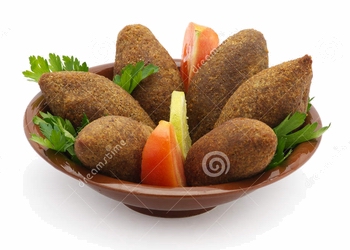Lebanese cuisine includes an abundance of starches,
whole grain, fruits, vegetables, fresh fish and
seafood; animal fats are consumed sparingly. Poultry
is eaten more often than red meat. When red meat is
eaten it is usually lamb on the coast, and goat meat
in the mountain regions. It also includes copious
amounts of garlic and olive oil, often seasoned by
lemon juice.; olive oil, herbs, garlic and lemon are
typical flavors found in the Lebanese diet.
Most often foods are either grilled, baked or
sautéed in olive oil; butter or cream is rarely used
other than in a few desserts. Vegetables are often
eaten raw or pickled as well as cooked. Herbs and
spices are used and the freshness of ingredients is
important. Like most Mediterranean countries, much
of what the Lebanese eat is dictated by the seasons. |
|
 |
In Lebanon, very rarely are drinks served without being
accompanied by food. Similar to the tapas of Spain, mezeluri
of Romania, and aperitivo of Italy, mezze is an array of
small dishes placed before the guests creating an array of
colors, flavors, textures and aromas. This style of serving
food is less a part of family life than it is of
entertaining and cafes. Mezze may be as simple as pickled
vegetables or raw vegetables, hummus, baba ghanouj and
bread, or it may become an entire meal consisting of grilled
marinated seafood, skewered meats, a variety of cooked and
raw salads and an arrangement of desserts.
Although simple fresh fruits are often served towards the
end of a Lebanese meal, there is also dessert, such as
baklava and coffee. Although baklava is the most
internationally known dessert, there is a great variety of
Lebanese desserts.
A typical mezze will consist of an elaborate variety of
thirty hot and cold dishes and may include:
Salads such as the tabbouleh and fattoush, together with dip
such as hummus, baba ghanouj or moutabal, and kebbeh.
Some patties such as the Sambusac.
Stuffed grape leaves
Family cuisine offers also a range of dishes, such as stews
or yakhnehs, which can be cooked in many forms depending on
the ingredients used and are usually served with meat and
rice vermicelli.
The Lebanese flat bread is a staple to every Lebanese meal
and can be used to replace the usage of the fork.
Arak, an anise-flavored liqueur, is the Lebanese national
alcoholic drink and is usually served with the traditional
convivial Lebanese meals. Another drink is Lebanese wine.
Lebanese sweets include:
Pastries such as baklava, Kaak, Sfouf and Maamoul.
The Lebanese ice cream with its oriental flavors (Amar el
Din made from dried apricot; fresh fruits; pistachio).
The Lebanese roasted nuts with variety and mixes.
Some dishes are also specifically prepared on special
occasions: the meghli dessert, for instance is served to
celebrate a newborn baby in the family.
History
The Lebanese cuisine is an ancient one and part of the
Levantine cuisine, which include the Egyptian cuisine,
Palestinian cuisine, Syrian cuisine etc.
Many dishes in the Lebanese cuisine can be traced back to
thousands of years to Roman, and even Phoenician times. For
most of its recent past, Lebanon has been ruled by foreign
powers that have influenced the types of food the Lebanese
ate. From 1516 to 1918, the Ottoman Turks controlled Lebanon
and introduced a variety of foods that have become staples
in the Lebanese diet, such as cooking with lamb.
After the Ottomans were defeated in World War I (1914–1918),
France took control of Lebanon until 1943, when the country
achieved its independence. This time, the French introduced
foods such as flan, a caramel custard dessert dating back to
the 16th century, and buttery croissants. came the same
kind of popular, quick meal as was already widespread in the
Mediterranean. |



